
Fin rot is a bacterial infection that commonly affects betta fish. This infection eats away at a betta’s beautiful fins and tail, causing them to look ragged and discolored.
While the effects of fin rot are small at first, if left untreated, the infection will get progressively worse until your betta dies.
Fortunately, there are multiple ways that you can cure and treat fin rot so that your betta makes a full recovery.
We will talk you through everything you need to know and help you to return your betta back to full health.
TABLE OF CONTENTS
What Is Fin Rot?

Fin rot is an infection characterized by ragged, deteriorating, discolored fins and caused by gram-negative bacteria (Pseudomonas fluorescens) or fungal pathogens. Your fish can become afflicted with fin rot due to poor water quality or a weakened immune system.
Your fish may have a weakened immune system for any number of reasons, including stress, irresponsible breeding practices, prior illness, injury, or inadequate water conditions.
If your fish gets fin rot, its fins will start to rot away, potentially deteriorating until it has no fins left. If left untreated, fin rot will eventually lead to the death of your fish.
Fin rot can be a problem for any fish (marine or freshwater), but bettas are particularly susceptible because their fins are so large and long. Ironically, this makes the problem more noticeable, so you should be able to spot it quickly and have a good chance of saving your betta.
While it can cause a lot of damage to your betta, fin rot is both treatable and preventable, so your fish is not doomed.
Is Fin Rot Contagious?
As a bacterial disease, fin rot is technically contagious, as the bacteria will multiply and can move to new fish through close contact.
However, if your betta’s tank mates have a strong immune system, they should be safe.
If you notice several of your fish getting fin rot at the same time, you likely have an issue in your tank that’s negatively affecting the immune systems of all your fish, such as poor water quality or conditions.
Symptoms
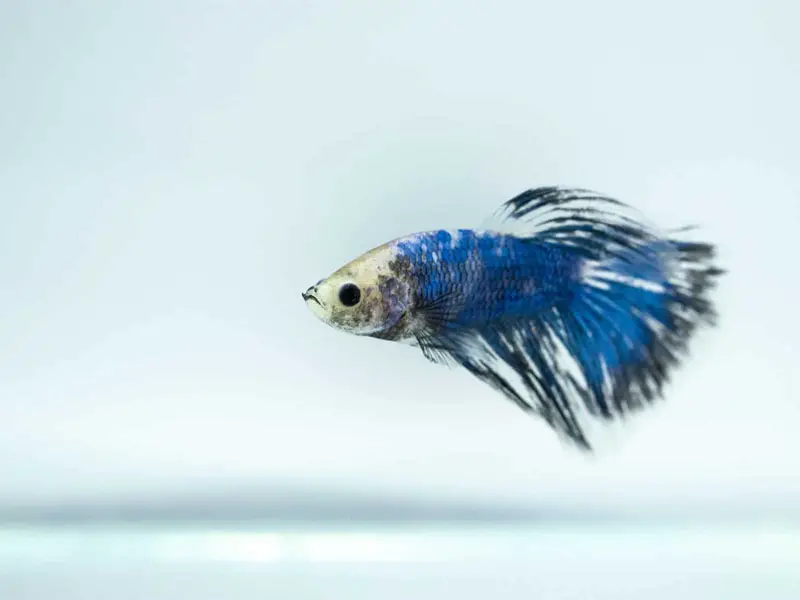
Fin rot is a disease that gets progressively worse over time. If it is left to run its course, your betta will eventually die. Luckily, the symptoms are quite conspicuous, so you should notice them early.
Symptoms of fin rot are most apparent on the tail fin, but the infection can affect any fin.
Initially, the infection will manifest itself as a thin white border on one of the fish’s fins. This white border may not necessarily stand out, depending on the color of the fish and its environment.
Over time, the white border will start getting thicker and more visible. It may darken in color too, somewhere from grey to brown to black, but it could remain white.
The colored area marks the infected area. As the border thickens, the bits on the edge will begin to fall away, shortening the fin and making it look frayed.
This could continue until the entire fin has been eaten away, making swimming incredibly difficult on your betta.
Once the fin is completely gone, the rotting can continue and start eating away at the body where the affected fin had been attached, causing inflammation.
Throughout the process, you may observe your betta behaving differently too.
A fish’s immune system has to work very hard when fighting off disease. This uses up a lot of energy, leaving them weak and fatigued.
To make the issue worse, fish affected with fin rot often lose their appetite and stop eating, so they receive less energy from their diet.
Your betta will likely begin to stay away from tank mates and might spend a lot of its time laying on the substrate to rest.
If you watch your fish regularly, you should be able to spot fin rot on your betta quite quickly. Their long flowing fins make deterioration and color change quite noticeable.
Fin rot is harder to spot on smaller fish until further symptoms arise.
Causes
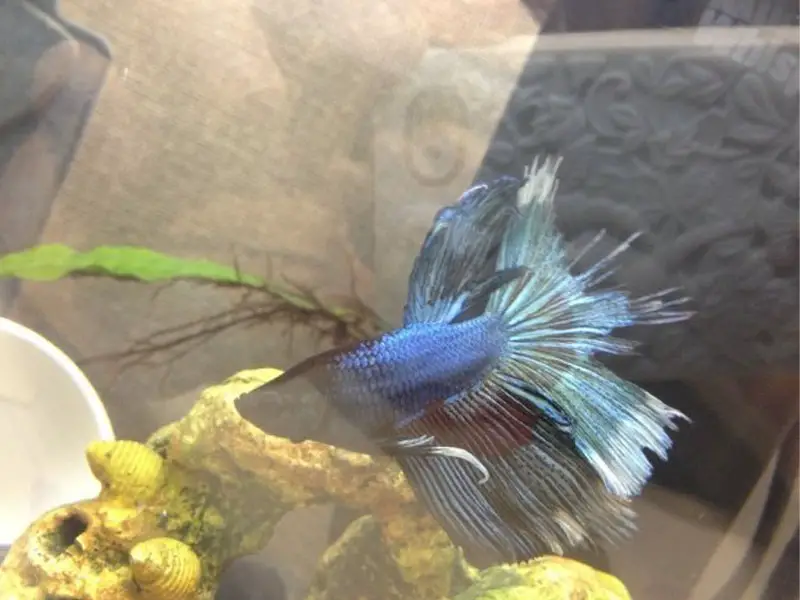
Usually, a pathogen needs to be introduced to an aquarium before a certain disease arises, perhaps when adding new fish or decorations.
However, the bacteria and pathogens that cause fin rot can often be found in aquariums without your fish having developed cases.
There are two possible types of pathogens that could cause the fin rot on your betta: the gram-negative bacteria called Pseudomonas fluorescens and a fungal pathogen.
These usually only become an issue if the immune system of your betta weakens, as it will be unable to fight them off effectively.
Poor Water Conditions
A weakened immune system is most often caused by poor water conditions in the aquarium.
Perhaps the temperature of the water has changed over a hot summer, or maybe there are too much feces in the tank due to overcrowding.
Whatever the reason for the poor conditions, you should be able to identify using a water testing kit and a thermometer, so you can then fix it.
Poor Diet
Another reason for a weakened immune system is a poor diet. You may not be feeding your betta enough, or it may not be receiving all of the nutrients it needs to stay healthy.
Is their diet composed solely of dried foods? This could be a problem because most of the nutrients are lost during manufacturing. Live or frozen foods are nutrient-rich, making them much better options.
A varied diet is an ideal one. This ensures that your betta will receive a wide range of nutrients.
Other Health Problems
Having one health problem leaves your betta more susceptible to developing more.
You might not have noticed that your betta had contracted another disease before fin rot. Fighting a disease uses energy, leaving them exposed to others.
Physical injuries make it easier for a pathogen to affect a fish because the wound offers another entry point to the body. Bettas are known to fight from time to time, so injuries can happen more often.
Bettas are a prime target for fin-nipping fish due to their long fins. This can easily lead to fin rot too.
Stress
A stressed fish will be less able to fight off disease. While the previous potential causes will result in stress, there are some more generic reasons for stress too.
Maybe there is a tank mate that keeps harassing your betta. It would be even worse if the tank mate were a fin-nipper since injuries make the disease more likely.
Bettas are well able to look after themselves, but fighting with tank mates uses up a lot of energy and stresses them out.
Bright lights can stress your betta, especially if they have nowhere shaded that they can go to hide.
Treating Fin Rot
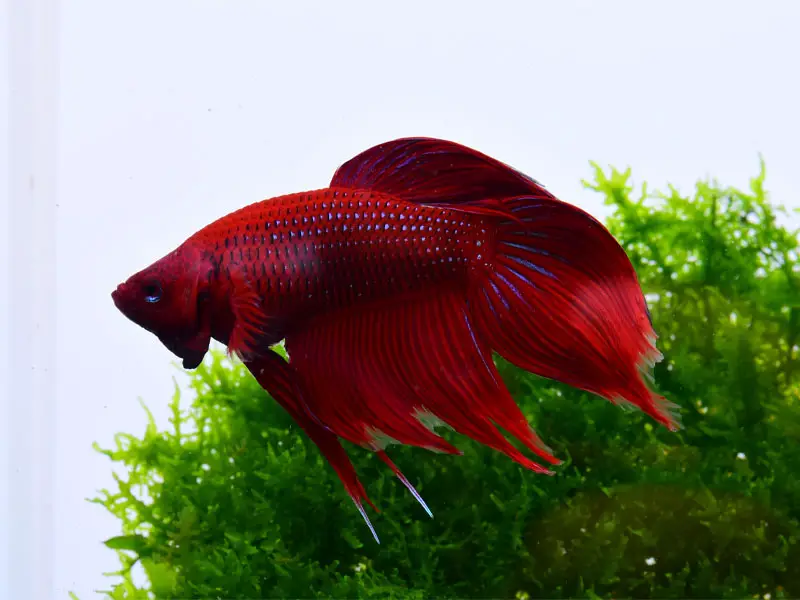
There are ways to treat fin rot of different stages and severities. The important thing is to start treatment as soon as possible to give your betta the best chance of survival.
If you can, set up a quarantine tank. This will help to prevent the spread of disease to other fish. It also protects the tank mates from any effects that the treatment may cause them.
Diagnosing
Treatments are unlikely to be ineffective if the underlying problem (e.g. poor water quality) is still occurring.
Before starting treatment, you need to diagnose what caused the fin rot in the first place. Once you have identified what the cause is, you can fix it and start treatment.
Check the temperature and use a water testing kit to determine the levels of nitrite, nitrate, and ammonia in the aquarium.
If the conditions are not right, perform a water change and give the tank a good wipe down. Cleaning the tank like this is a good idea even if the conditions seem okay.
Think about what you are feeding your fish and if their diet is as healthy as it could be. Change their diet if you need to, though your betta may not accept it right away if it’s lacking an appetite.
You will need the perfect environment for your betta if you want it to recover. Once conditions are perfect, remove anything that causes stress, such as boisterous tank mates.
Depending on the treatment, separating your betta is usually a good idea anyway, to avoid the treatment affecting the rest of your fish.
Diagnosing and fixing the initial problem can sometimes be enough to help your betta fight off the disease, without the need for further treatment.
Treating Mild Fin Rot
You can choose a treatment based on how advanced the fin rot is.
Mild fin rot will have arisen recently, so the fin tips will have started to change color and possibly started fraying as the first few pieces fall away.
Treating mild fin rot involves adding freshwater aquarium salt to the water (not table salt). This can be found in most pet stores.
The aquarium salt helps to heal wounds and reduce stress. It will damage your live plants though, so make sure there aren’t any in the tank.
Add one teaspoon of aquarium salt for each gallon of water in the aquarium. Pre-mix the salt in the water before adding it to the tank since the raw salt can hurt your betta.
Perform a 90% water change every day, treating the new water with the appropriate amount of salt each time.
The amount of salt you need to add may vary depending on the brand you purchase, so read the packaging carefully before the first dose.
Do not use this treatment for longer than 10 days. Prolonged exposure to salt can poison your betta and damage their kidneys.
If there has been no positive effect after 10 days, try the next treatment.
Treating Advanced Fin Rot
Advanced fin rot will likely have been a problem for a bit longer. Large portions of the fins will have started to fall away.
Treating advanced fin rot involves using medications.
Some medications can lower the oxygen content of the water, so it is worth adding an air stone to your quarantine tank.
If you are using a filter with carbon, remove the carbon as it can strip the medication from the water.
Follow the dosing instructions on the medication you have purchased.
Before each treatment, perform a large water change to avoid overdosing. Hopefully, you will see some improvements after a week or two. Once treatment is complete, you can return your betta to its regular aquarium.
Any new growth that develops on their fin will be delicate, so mate sure their environment is calm and without any boisterous tank mates. Sharp decorations should be avoided too.
How Do you Know if Fin Rot Is Cured?
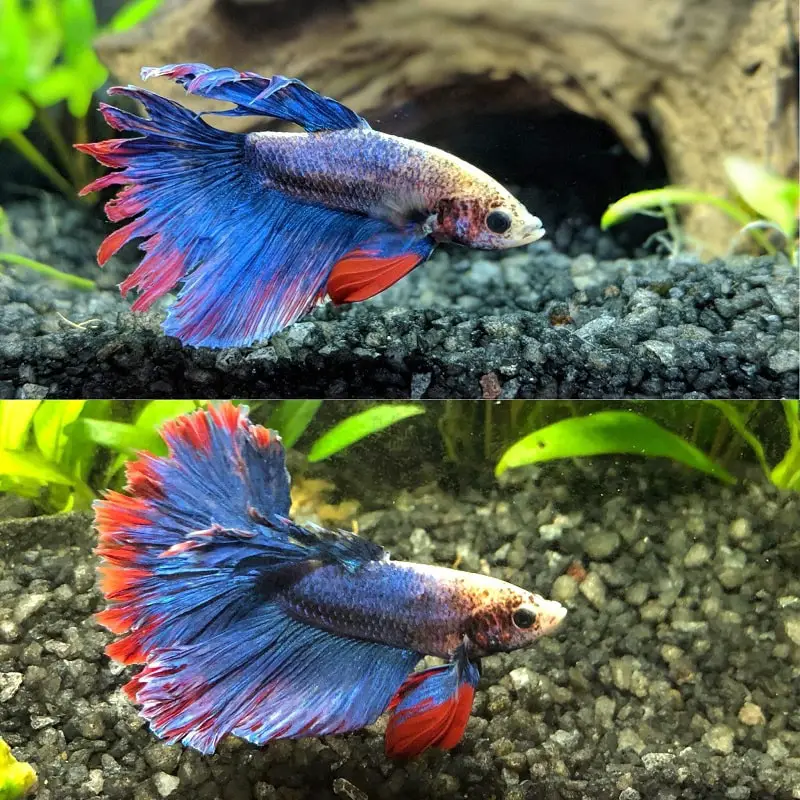
Treatments can take a few days or even weeks to be effective, so do not be disheartened if your betta does not show any immediate improvements.
Rather than looking for improvements, look for any signs that the infection is getting worse. If the fin is no longer deteriorating and is staying a consistent size, then you will likely see improvements soon.
You will eventually spot some regrowth of the fin as the dead parts are replaced. This should be coupled with some healthier-looking colors.
You should see some improvements in their behavior too. Hopefully, their appetite will improve, so they can begin to feed like normal. This will increase their energy levels so they can move around the aquarium more easily.
Keep a close eye on your betta. You should be able to judge when its fins and behavior have returned to normal.
Preventing Fin Rot
If you have never experienced fin rot in your aquarium, or you don’t want it to happen again, taking preventative measures will help you to avoid the anxiety of potentially losing your fish in the future.
Before even starting your aquarium, there are steps you can take to reduce the chance of disease.
Try to get the largest tank that you can. It is much easier for pollutants to build up quickly in a smaller volume of water, so it is harder to maintain the perfect conditions.
Think carefully about the bioload that your tank and filtration system can handle. Overcrowding the tank will produce too much waste and lower the quality of the water, not to mention stress on your fish.
Once the aquarium is up and running, having a regular tank cleaning routine is the best thing you can do to prevent fin rot.
Diseases thrive in poor water conditions, so don’t give them the opportunity.
A clean tank will help to keep your betta’s immune system strong, as will a healthy and nutritious diet.
Whenever you are watching your betta, look carefully at their fins for signs of a color change. Observing your fish regularly will help you to spot disease as quickly as possible.
The sooner you find the disease, the quicker and more effective treatment should be.
Buying Your Betta
Be vigilant when buying your betta and check that it does not already have fin rot. The disease can be common in pet stores depending on their quality of care.
Look over the betta that you intend to purchase. A deteriorating tail or loss of color on the fin tips are good indicators that the fish has fin rot. These should be easy to spot.
Take this time to look for signs of other diseases too, such as the white spots associated with ich, or even just physical injuries.
If you notice anything out of the ordinary, the safest option is to shop elsewhere. Buying a healthy betta is crucial to it surviving the transition into your aquarium.
Conclusion
If your betta is experiencing fin rot, it is easy to panic and think that the worst will happen.
Take a step back to figure out what has caused the problem. You can then fix this and move on to treating your fish in a quarantine tank.
There are a couple of methods for you to choose from, each is useful for different stages of fin rot. If one does not work, you have the other to fall back on.
Once your betta is back to full health, you can return it to your main aquarium and take preventative measures to reduce the chance of fin rot making a return.
It is important to remind yourself that fin rot is a common disease that many people encounter, so you are not a bad aquarist if it develops in your tank.
Whatever the cause, start treating your betta as soon as possible and it should be fine.
Have you experienced fin rot before? Let us know what happened in the comments below…




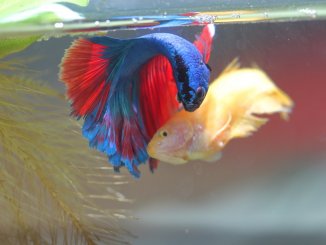



Be the first to comment